List of Pelecaniformes by population
| The population of birds |
|---|
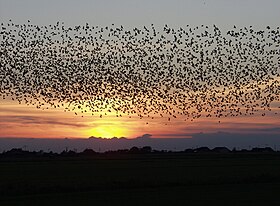 |
This is a list of Pelecaniformes species by global population. While numbers are estimates, they have been made by the experts in their fields. For more information on how these estimates were ascertained, see Wikipedia's articles on population biology and population ecology.
This list is not comprehensive, as not all Pelecaniformes have had their numbers quantified.
Species by global population
| Common name | Binomial name | Population | Status | Trend | Notes | Image |
|---|---|---|---|---|---|---|
| Dwarf ibis | Bostrychia bocagei | 190-2,500[1] | CR[1]
|
Estimate calculated from density and area estimates. Equal to 130-1,700 mature individuals.[1] | 
| |
| Northern bald ibis | Geronticus eremita | 200-249[2] | EN[2] | Estimate for mature individuals only. Species is considered regionally extinct in Europe.[2] | 
| |
| Giant ibis | Thaumatibis gigantea | 290[3] | CR[3]
|
Minimum estimate. Equal to 194 mature individuals.[3] | 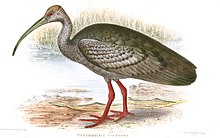
| |
| White-eared night-heron | Oroanassa magnifica | 350-1,500[4] | EN[4] | Equal to 250-999 mature individuals.[4] | 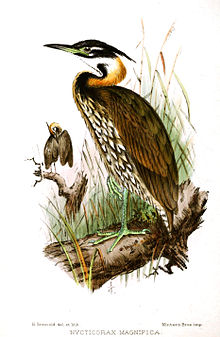
| |
Rough-faced shag |
Phalacrocorax carunculatus | 350 – 1500[5] | VU[5] | 
| ||
Asian crested ibis
|
Nipponia nippon | 550[6] | EN[6] | Equal to 330 mature individuals.[6] | 
| |
| Bounty shag | Phalacrocorax ranfurlyi | 620[7] | VU[7] | Minimum estimate.[7] | ||
| White-shouldered ibis | Pseudibis davisoni | 1,000[8] | CR[8]
|
Minimum estimate. Equal to 670 mature individuals.[8] | 
| |
| Fasciated tiger-heron | Tigrisoma fasciatum | 1,000-10,000[9] | LC[9]
|
Unknown[9] | Equal to 670-6,700 mature individuals.[9] | 
|
Schrenck's bittern
|
Ixobrychus eurhythmus | 1,000-25,000[10] | LC[10]
|
Equal to 670-17,000 mature individuals.[10] | 
| |
| Wattled ibis | Bostrychia carunculata | 1,000-25,000[11] | LC[11]
|
Unknown[11] | Equal to 670-17,000 mature individuals.[11] | 
|
| Chatham shag | Phalacrocorax onslowi | 1070[12] | CR[12] |
|||
| Pitt shag | Phalacrocorax featherstoni | 1400[13] | EN[13] | |||
| Australasian bittern | Botaurus poiciloptilus | 1,500-4,000[14] | VU[14] | Equal to 1,000-2,499 mature individuals.[14] | 
| |
| Flightless cormorant | Phalacrocorax harrisi | 1679[15] | VU[15] | 
| ||
| Malayan night-heron | Gorsachius melanolophus | 2,000-20,000[16] | LC[16]
|
Unknown[16] | Equal to 1,300-13,000 mature individuals. Subpopulations include 100-10,000 breeding pairs in Taiwan, and 100-10,000 in Japan.[16] | 
|
| Forest bittern | Zonerodius heliosylus | 2,500-9,999[17] | NT[17]
|
Equal to 1,500-7,000 mature individuals.[17] | 
| |
Madagascar sacred ibis
|
Threskiornis bernieri | 2,600-3,250[18] | EN[18] | Equal to 1,733-2,166 mature individuals.[18] | 
| |
| Olive ibis | Bostrychia olivacea | 3,000-45,000[19] | LC[19]
|
Estimate is for mature individuals only.[19] | 
| |
| Christmas frigatebird | Fregata andrewsi | 3600 – 7200[20] | VU[20] | 
| ||
| Black-faced spoonbill | Platalea minor | 3,941[21] | EN[21] | Equal to approximately 2,250 mature individuals.[21] | 
| |
| Auckland shag | Phalacrocorax colensoi | 4500[22] | VU[22] | |||
| Bronze shag | Phalacrocorax chalconotus | 5000 – 8000[23] | VU[23] | Numbers may be overestimated.[23] | 
| |
| Shoebill | Balaeniceps rex | 5000 – 8000[24] | VU[24] | 
| ||
| Red-billed tropicbird | Phaethon aethereus | 5000 – 20 000[25] | LC[25] |

| ||
| Southern bald ibis | Geronticus calvus | 6,500-8,000[26] | VU[26] | Equal to 3,300-4,000 mature individuals and 1,650-2,000 breeding pairs.[26] | 
| |
| African spoonbill | Platalea alba | 7,300-73,000[27] | LC[27]
|
Estimate is for mature individuals only.[27] | 
| |
| Japanese night-heron | Gorsachius goisagi | 7,500-15,000[28] | VU[28] | Equal to 5,000-9,999 mature individuals.[28] | 
| |
| Campbell shag | Phalacrocorax campbelli | 8000[29] | VU[29] | Estimate may be dated.[29] | ||
| Bank cormorant | Phalacrocorax neglectus | 8400[30] | EN[30] | 
| ||
| Crowned cormorant | Phalacrocorax coronatus | 8700[31] | NT[31] |
|||
| Abbott's booby | Papasula abbotti | 9000[32] | EN[32] | |||
Madagascar crested ibis
|
Lophotibis cristata | 10,000[33] | NT[33]
|
Equal to 6,700 mature individuals.[33] | 
| |
| Puna ibis | Plegadis ridgwayi | 10,000-15,000[34] | LC[34]
|
Equal to 6,700-10,000 mature individuals.[34] | 
| |
| Sharp-tailed ibis | Cercibis oxycerca | 10,000-25,000[35] | LC[35]
|
Equal to 6,700-17,000 mature individuals.[35] | 
| |
| Dalmatian pelican | Pelecanus crispus | 10 000 – 13 900[36] | VU[36] | 
| ||
| Spot-billed pelican | Pelecanus philippensis | 13 000 – 18 000[37] | NT[37] |

| ||
| Black-headed ibis | Threskiornis melanocephalus | 15,000-30,000[38] | NT[38]
|
Equal to 10,000-19,999 mature individuals. Subpopulation estimates include 10,000 in south Asia, 10,000 in south-east Asia, and 100 in east Asia.[38] | 
| |
| White-backed night-heron | Calherodius leuconotus | 25,000-100,000[39] | LC[39]
|

| ||
| White-crested tiger-heron | Tigrionrnis leucolopha | 25,000-100,000[40] | LC[40]
|

| ||
| Black-faced ibis | Theristicus melanopis | 25,000-100,000[41] | LC[41]
|

| ||
| Ascension frigatebird | Fregata aquila | 25 000 – 32 000[42] | VU[42] | Unknown[42] | 
| |
| Japanese cormorant | Phalacrocorax capillatus | 25 000 – 100 000[43] | LC[43] |
Unknown[43] | 
| |
| Rufescent tiger-heron | Tigrisoma lineatum | 27,700-105,500[44] | LC[44]
|
Equal to 18,000-70,000 mature individuals.[44] | 
| |
| Red-legged cormorant | Phalacrocorax gaimardi | 30 000[45] | NT[45] |

| ||
| Nazca booby | Sula granti | 30 000[46] | LC[46] |
Minimum estimate.[46] | 
| |
| Red-tailed tropicbird | Phaethon rubricauda | 32 000[47] | LC[47] |
Minimum estimate.[47] | 
| |
| Oriental darter | Anhinga melanogaster | 33 000[48] | NT[48] |
Minimum estimate.[48] | 
| |
| White-tailed tropicbird | Phaethon lepturus | 50 000[49] | LC[49] |
Minimum estimate.[49] | 
| |
| Pinnated bittern | Botaurus pinnatus | 50,000-499,999[50] | LC[50]
|
Estimate is for mature individuals only.[50] | 
| |
| Agami heron | Agamia agami | 50,000-499,999[51] | VU[51]
|
Unknown[51] | Calculation may need to be revised. Actual global population may be smaller.[51] | 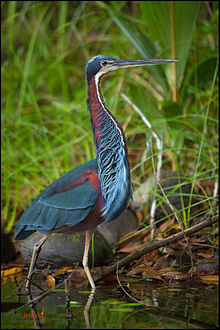
|
| Bare-throated tiger-heron | Tigrisoma mexicanum | 50,000-499,999[52] | LC[52]
|
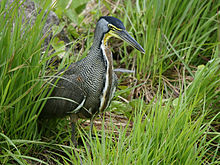
| ||
| Green ibis | Mesembrinibis cayennensis | 50,000-499,999[53] | LC[53]
|
Estimate is for mature individuals only.[53] | 
| |
| Eurasian spoonbill | Platelea leucorodia | 63,000-65,000[54] | LC[54]
|
Unknown[54] | European subpopulation includes 20,400-30,500 mature individuals.[54] | 
|
| Black bittern | Ixobrychus flavicollis | 63,000-320,000[55] | LC[55]
|
Subpopulation at China is 100-100,000 breeding pairs.[55] | 
| |
| Pygmy cormorant | Phalacrocorax pygmeus | 85 000 – 180 000[56] | LC[56] |

| ||
| Yellow bittern | Ixobrychus sinensis | 100,000-1,000,000[57] | LC[57]
|
Unknown[57] | 
| |
| Straw-necked ibis | Threskiornis spinicollis | 100,000-1,000,000[58] | LC[58]
|
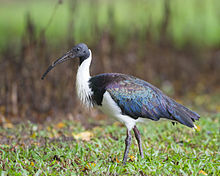
| ||
| Peruvian pelican | Pelecanus thagus | 100 000 – 1 000 000[59] | NT[59] |

| ||
| Socotra cormorant | Phalacrocorax nigrogularis | 110 000[60] | VU[60] | 
| ||
| Eurasian bittern | Botaurus stellaris | 115,000-340,000[61] | LC[61]
|
European subpopulation includes 75,300-133,000 mature individuals.[61] | 
| |
| Cinnamon bittern | Ixobrychus cinnamomeus | 130,000-2,000,000[62] | LC[62]
|

| ||
| American white pelican | Pelecanus erythrorhynchos | 180 000[63] | LC[63] |

| ||
| Brown booby | Sula leucogaster | 200 000[64] | LC[64] |
Minimum estimate.[64] | 
| |
| African sacred ibis | Threskiornis aethiopicus | 200,000-450,000[65] | LC[65]
|
Estimate is for mature individuals only.[65] | 
| |
| Spot-breasted ibis | Bostrychia rara | 200,000-510,000[66] | LC[66]
|
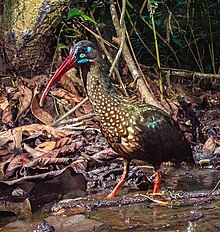
| ||
| Glossy ibis | Plegadis falcinellus | 200,000-2,300,000[67] | LC[67]
|
This estimate involves the European subpopulation of 56,500-75,400 mature individuals.[67] | 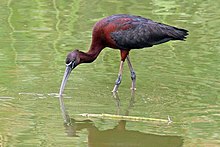
| |
| White ibis | Eudocimus albus | 210,000-360,000[68] | LC[68]
|
Estimate is for mature individuals only.[68] | 
| |
| Striated heron | Butorides striata | 260,000-2,300,000[69] | LC[69]
|
Equal to 173,000-1,500,000 mature individuals. Will likely need to be revised under recent taxonomic changes.[69] | 
| |
| Red-faced cormorant | Phalacrocorax urile | 200 000[70] | LC[70] |
Minimum estimate.[70] | ||
| Cape cormorant | Phalacrocorax capensis | 200 000 – 250 000[71] | NT[71] |

| ||
| Cape gannet | Morus capensis | 300 000[72] | VU[72] | Mature population only (~150 000 pairs).[72] | 
| |
| Squacco heron | Ardeola rallodies | 370,000-780,000[73] | LC[73]
|
European subpopulation estimated at 30,000-51,700 mature individuals.[73] | 
| |
| Boat-billed heron | Cochlearius cochlearius | 500,000-4,999,999[74] | LC[74]
|

| ||
| Black-crowned night-heron | Nycticorax nycticorax | 570,000-3,730,000[75] | LC[75]
|
Subpopulations include 120,000-172,000 mature individuals in Europe.[75] | 
| |
| Common little bittern | Ixobrychus minutus | 630,000-1,110,000[76] | LC[76]
|
Estimate is for mature individuals only. Further validation is needed.[76] | 
| |
| Northern gannet | Morus bassanus | 950 000 – 1 200 000[77] | LC[77] |

| ||
| Red-footed booby | Sula sula | 1 000 000[78] | LC[78] |
Minimum estimate.[78] | 
| |
| White-faced ibis | Plegadis chihi | 1,200,000[79] | LC[79]
|
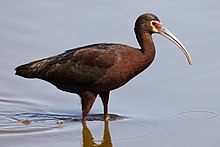
| ||
| Great cormorant | Phalacrocorax carbo | 1 400 000 – 2 900 000[80] | LC[80] |

| ||
| Neotropic cormorant | Phalacrocorax brasilianus | 2 000 000[81] | LC[81] |

| ||
| Guanay cormorant | Phalacrocorax bougainvillii | 2 500 000 – 4 999 999[82] | NT[82] |

|
See also
- Lists of birds by population
- Lists of organisms by population
References
- ^ .
- ^ .
- ^ .
- ^ .
- ^ a b c BirdLife International (2012). "Phalacrocorax carunculatus". IUCN Red List of Threatened Species. 2012. Archived from the original on 2013-09-25. Retrieved 2012-12-14.
- ^ .
- ^ a b c d BirdLife International (2012). "Phalacrocorax ranfurlyi". IUCN Red List of Threatened Species. 2012. Archived from the original on 2012-12-28. Retrieved 2012-12-15.
- ^ .
- ^ .
- ^ .
- ^ .
- ^ a b c BirdLife International (2012). "Phalacrocorax onslowi". IUCN Red List of Threatened Species. 2012. Archived from the original on 2013-09-25. Retrieved 2012-12-15.
- ^ . Retrieved 20 November 2021.
- ^ a b c d "Botaurus poiciloptilus: BirdLife International". IUCN Red List of Threatened Species. 2012-06-01. Retrieved 2022-12-24.
- ^ a b c BirdLife International (2012). "Phalacrocorax harrisi". IUCN Red List of Threatened Species. 2012. Archived from the original on 2012-11-12. Retrieved 2012-12-14.
- ^ .
- ^ .
- ^ .
- ^ .
- ^ . Retrieved 20 November 2021.
- ^ .
- ^ a b c BirdLife International (2012). "Phalacrocorax colensoi". IUCN Red List of Threatened Species. 2012. Archived from the original on 2012-12-28. Retrieved 2012-12-14.
- ^ a b c d BirdLife International (2012). "Phalacrocorax chalconotus". IUCN Red List of Threatened Species. 2012. Archived from the original on 2013-09-25. Retrieved 2012-12-14.
- ^ . Retrieved 20 November 2021.
- ^ . Retrieved 20 November 2021.
- ^ .
- ^ .
- ^ .
- ^ a b c d BirdLife International (2012). "Phalacrocorax campbelli". IUCN Red List of Threatened Species. 2012. Archived from the original on 2012-12-28. Retrieved 2012-12-14.
- ^ . Retrieved 20 November 2021.
- ^ a b c BirdLife International (2012). "Phalacrocorax coronatus". IUCN Red List of Threatened Species. 2012. Archived from the original on 2012-11-11. Retrieved 2012-12-14.
- ^ . Retrieved 20 November 2021.
- ^ .
- ^ .
- ^ .
- ^ . Retrieved 20 November 2021.
- ^ . Retrieved 20 November 2021.
- ^ .
- ^ .
- ^ .
- ^ .
- ^ . Retrieved 20 November 2021.
- ^ . Retrieved 20 November 2021.
- ^ a b c d "Tigrisoma lineatum: BirdLife International". IUCN Red List of Threatened Species. 2012-05-01. Retrieved 2022-12-24.
- ^ a b c BirdLife International (2012). "Phalacrocorax gaimardi". IUCN Red List of Threatened Species. 2012. Archived from the original on 2013-09-25. Retrieved 2012-12-14.
- ^ . Retrieved 20 November 2021.
- ^ . Retrieved 20 November 2021.
- ^ . Retrieved 20 November 2021.
- ^ . Retrieved 20 November 2021.
- ^ .
- ^ .
- ^ .
- ^ .
- ^ .
- ^ .
- ^ a b c BirdLife International (2012). "Phalacrocorax pygmeus". IUCN Red List of Threatened Species. 2012. Archived from the original on 2012-11-14. Retrieved 2012-12-15.
- ^ .
- ^ .
- ^ . Retrieved 20 November 2021.
- ^ . Retrieved 20 November 2021.
- ^ .
- ^ .
- ^ . Retrieved 20 November 2021.
- ^ . Retrieved 20 November 2021.
- ^ .
- ^ .
- ^ .
- ^ .
- ^ a b c d "Butorides striata: BirdLife International". IUCN Red List of Threatened Species. 2016-10-01. Retrieved 2022-12-24.
- ^ a b c d BirdLife International (2012). "Phalacrocorax urile". IUCN Red List of Threatened Species. 2012. Archived from the original on 2013-09-25. Retrieved 2012-12-15.
- ^ . Retrieved 20 November 2021.
- ^ . Retrieved 20 November 2021.
- ^ .
- ^ .
- ^ .
- ^ .
- ^ . Retrieved 20 November 2021.
- ^ . Retrieved 20 November 2021.
- ^ .
- ^ . Retrieved 20 November 2021.
- ^ a b c BirdLife International (2012). "Phalacrocorax brasilianus". IUCN Red List of Threatened Species. 2012. Archived from the original on 2013-04-22. Retrieved 2012-12-14.
- ^ a b c BirdLife International (2012). "Phalacrocorax bougainvillii". IUCN Red List of Threatened Species. 2012. Archived from the original on 2013-03-16. Retrieved 2012-12-14.
